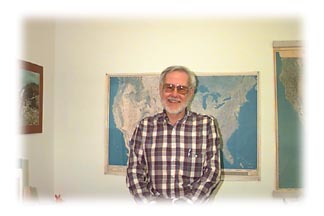Peter U. Rodda
 B.A., Ph.D., University of California,
Los Angeles (1952, 1960). Research Scientist, Associate Professor, University of Texas (1958-1971). California
Academy of Sciences (1971- ). Adjunct Professor, San Francisco State University (1972-1992 ). Fellow, Geological
Society of America; California Academy of Sciences. Member, American Association of Petroleum Geologists; Paleontological
Society; Society of Economic Paleontologists and Mineralogists; California Malacozoological Society. Registered
Professional Geologist, State of California. B.A., Ph.D., University of California,
Los Angeles (1952, 1960). Research Scientist, Associate Professor, University of Texas (1958-1971). California
Academy of Sciences (1971- ). Adjunct Professor, San Francisco State University (1972-1992 ). Fellow, Geological
Society of America; California Academy of Sciences. Member, American Association of Petroleum Geologists; Paleontological
Society; Society of Economic Paleontologists and Mineralogists; California Malacozoological Society. Registered
Professional Geologist, State of California.
My general research interest is the geological history and evolution of fossil mollusks during the past 130
million years. To delineate these patterns I use the geological methods of biostratigraphy (the precise determination
of the distribution of various fossil species through sequences of strata) and paleoecology (the interpretation
of the environments in which ancient organisms lived, died, and were fossilized).
Currently, I am involved in describing the distribution, diversity, and geological history of ammonites (an
extinct group of shelled cephalopods related to squid and Nautilus) from Cretaceous strata (130 to 65 million years
old) exposed in the Sacramento Valley, California. Ammonites evolved rapidly and they are common and widespread,
making them especially useful fossils for determining geological ages of the enclosing strata. I am concentrating
my work in the Cottonwood District in the northwestern Sacramento Valley. This area, which is famous for its ammonites,
has one of the finest sequences of fossiliferous Cretaceous rocks in the world and it has served as a standard
of reference for the Pacific Coast for over a hundred years. The fossils and strata are still inadequately known,
however, and my goal is to establish a refined and expanded ammonite database which will make this area a world
standard of reference for this interval of geological time.
Rodda, P.U. 1969. (with M.A. Murphy and D.M. Morton). Geology of the Ono quadrangle, Shasta and Tehama Counties,
California. California Division of Mines and Geology, Bulletin 192:28pp.
____________. 1978. (with M.A.Murphy). Paleontological resources reconnaissance, Cottonwood Creek Project. U.S.Army
Corps of Engineers, Sacramento (Calif.) District. 84 pp.
____________. 1985. (with M.A.Murphy). Paleontological survey, Cottonwood Creek Project. U.S.Army Corps of Engineers,
Sacramento (Calif.) District. i-ix, 1-69, appendix 1-359).
____________. 1987. (with M.A. Murphy). Paleontological Survey, Hulen Reservoir Project. California Department
of Water Resources, Northern District. i-viii, 1-308.
____________. 1992. (with M.A. Murphy). Two occurrences of the genus Pictetia (Early Cretaceous, Albian,
Ammonoidea) in California. Journal Paleontology 66(3): 435-439.
____________. 1995. (with M.A. Murphy and P. Imbree). A new heteromorph ammonite from the Barremian of California.
Journal Paleontology 69(6): 1179-1182.
____________. 1996 (with M.A. Murphy). The Albian-Cenomanian boundary in northern California. Geological Society
America, Bulletin. 108(2):235-250.
____________. 1996. (with M.A. Murphy). Schuchmanoceras hamicarinatum, gen. nov., sp. nov., a keeled
heteromorph ammonite from the Cretaceous (Albian) of California. Veliger 39(2): 173-177.
|